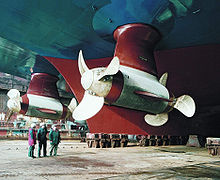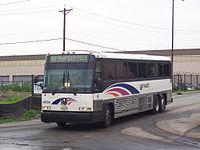- Diesel-electric transmission
-
Diesel-electric transmission or diesel-electric powertrain is used by a number of vehicle and ship types for providing locomotion.
A diesel-electric transmission system includes a diesel engine connected to an electrical generator, creating electricity that powers electric traction motors. No clutch is required.
Before diesel engines came into widespread use, a similar system, using a petrol (gasoline) engine and called petrol-electric or gas-electric, was sometimes used.
This kind of power transmission is used on railways by diesel electric locomotives and diesel electric multiple units as only electric motors are able to supply full torque at 0 RPM. Diesel-electric systems are also used in submarines and surface ships and some land vehicles.
In some high-efficiency applications, electrical energy may be stored in rechargeable batteries, in which case these vehicles can be considered as a class of hybrid electric vehicle.
Contents
Ships
See also: Ship#Propulsion_systems and electric boat Siemens Schottel azimuth thrusters
Siemens Schottel azimuth thrusters
The first diesel motorship was also the first diesel-electric ship, the Russian tanker Vandal from Branobel, which was launched in 1903. Steam turbine-electric propulsion has been in use since the 1920s (Tennessee class battleships), using diesel-electric powerplants in surface ships has increased lately. The Finnish coastal defence ship Ilmarinen, laid down in 1929, was among the first surface ships to use diesel-electric transmission. Later, the technology was used in diesel powered icebreakers.
Some modern ships, including cruise ships and icebreakers, use electric motors in pods called azimuth thrusters underneath to allow for 360° rotation, making the ships far more manoeuvrable.
Gas turbines are also used for electrical power generation and some ships use a combination: the Queen Mary 2 has a set of diesel engines in the bottom of the ship plus two gas turbines mounted near the main funnel; all are used for generating electrical power, including that used to drive the propellers.
Submarines
See also: Submarine#PropulsionEarly submarines used a direct mechanical connection between the engine and propeller, switching between diesel engines for surface running, and electric motors for submerged propulsion.
True diesel-electric transmissions for submarines were first proposed by the United States Navy's Bureau of Engineering in 1928; instead of driving the propeller directly while running on the surface, the submarine's diesel would instead drive a generator which could either charge the submarine's batteries or drive the electric motor. This meant that motor speed was independent of the diesel engine's speed, and the diesel could run at an optimum and non-critical speed, while one or more of the diesel engines could be shut down for maintenance while the submarine continued to run using battery power. The concept was pioneered in 1929 in the S-class submarines S-3, S-6, and S-7 to test the concept. No other navy adopted the system before 1945, apart from the British Royal Navy's U-class submarines, though some submarines of the Imperial Japanese Navy used separate diesel generators for low speed running.[1]
In a diesel-electric direct drive arrangement, the (usually single) propeller is driven directly by an electric motor, while two or more diesel-generators provide electric energy for charging the batteries and/or driving the electric motor. This mechanically isolates the noisy engine compartment from the outer pressure hull and reduces the acoustic signature of the submarine. Additionally some nuclear submarines also decouple their reactor room this way, having turbo-electric propulsion driven by reactor steam. Many submarines with diesel and electrical propulsion are mistakenly referred to as "diesel-electric" when they in fact have separately coupled diesel and electric engines.
Railways
Main articles: Diesel-electric locomotive and Diesel electric multiple unitIn the 1920s, diesel-electric technology first saw limited use in switchers (or shunters), locomotives used for moving trains around in railroad yards and assembling and disassembling them. One of the first companies to offer "Oil-Electric" locomotives was the American Locomotive Company (ALCO). The ALCO HH series of diesel-electric switcher entered series production in 1931. In the 1930s, the system was adapted for streamliners, the fastest trains of their day. Diesel-electric powerplants became popular because they greatly simplified the way motive power was transmitted to the wheels and because they were both more efficient and had greatly reduced maintenance requirements. Direct-drive transmissions can become very complex, considering that a typical locomotive has four or more axles. Additionally, a direct-drive diesel locomotive would require an impractical number of gears to keep the engine within its powerband; coupling the diesel to a generator eliminates this problem. An alternative is to use a torque converter or fluid coupling in a direct drive system to replace the gearbox. Hydraulic transmissions are claimed to be somewhat more efficient than diesel-electric technology.[1]
Road and other land vehicles
Trucks
See also: Category:Hybrid trucksExamples include:
- Large mining machines, such as the Liebherr T 282B dump truck or LeTourneau L-2350 wheel loader.
- NASA's huge Crawler-Transporters.
- Mitsubishi Fuso Canter Eco Hybrid commercial truck.
- International DuraStar Hybrid diesel-electric truck.[2]
- Dodge is conducting fleet tests of a diesel-electric version of the Dodge Sprinter.[3][4]
Concepts
See also: Hybrid vehicleIn the automobile industry, diesel engines in combination with electric transmissions and battery power are being developed for future vehicle drive systems. Partnership for a New Generation of Vehicles was a cooperative research program between the U.S. government and the Detroit three Automobile manufacturer DaimlerChrysler, Ford Motor Company, and General Motors Corporation that developed diesel hybrid cars.
- "Third-Millennium Cruiser", an attempt to commercialize a diesel-electric automobile in the very early 1980s.
- General Motors Precept
- Ford Prodigy
- Dodge Intrepid ESX
- Ford Reflex is a diesel hybrid concept car.[5]
- Zytek develops world’s first Affordable Ultra Efficient Diesel Hybrid Powertrain System.[6][7]
- Citroën C-Cactus[8]
- Chevrolet Volt/Opel Flextreme
- Top Gear Hammerhead Eagle-i Thrust
- Rivian Automotive is developing a diesel-electric engine that should achieve an estimated 90 miles per gallon in the city and over 100 miles per gallon on the highway[9]
Production Ready Cars
- Volkswagen Golf TDI Hybrid[10]
- Mercedes-Benz E-Class E300 BlueTEC hybrid
- Peugeot 3008 Crossover with HYbrid4 technology
- Volvo V60 plug-in diesel hybrid[11]
Other land vehicles
Diesel-electric propulsion was tried on some military vehicles, such as tanks. Ferdinand Porsche was the main developer of such drive-trains for military vehicles in World War II Nazi Germany, and created the Elefant tank destroyer and the prototypes of the never-produced, 200-ton class Maus super-heavy tank.
Buses
 MCI diesel electric prototype bus with batteries under the floor
MCI diesel electric prototype bus with batteries under the floor See also: Hybrid vehicle and :Category:Hybrid buses
See also: Hybrid vehicle and :Category:Hybrid busesDiesel electric based buses have also been produced, including hybrid systems able to run on and store electrical power in batteries. The two main providers of hybrid systems for diesel-electric transit buses include Allison Transmission and BAE Systems. New Flyer Industries, Gillig Corporation, and North American Bus Industries are major customers for the Allison EP hybrid systems, while Orion Bus Industries is a major customer for the BAE HybriDrive system. Mercedes-Benz makes their own diesel-electric drive system, which is used in their Citaro.
References
- ^ Friedman, Norman (1995). [1557502633 U.S. submarines through 1945: an illustrated design history]. Naval Institute Press. pp. 259–260. 1557502633.
- ^ International starts hybrid production - eTrucker
- ^ Dodge Sprinter Plug-in Hybrid Electric Vehicle (PHEV)
- ^ Dodge - 2007 Sprinter - Passenger Vans, Cargo Vans
- ^ Diesel hybrid car also taps the sun - Green Machines - MSNBC.com
- ^ World’s first affordable diesel hybrid powertrain
- ^ UK Company Zytek develops Affordable Ultra Efficient Diesel Hybrid System
- ^ Frankfurt Green: Citroen C-Cactus - The Car Connection
- ^ "Rivian Automotive - Waves of Change". Automoblog. 11 August 2011. http://www.automoblog.net/2011/08/11/rivian-automotive-waves-of-change. Retrieved 11 August 2011.
- ^ Geneva 2008: Volkswagen Golf TDI Hybrid
- ^ Volvo's production-ready V60 Plug-in Diesel Hybrid
External links
- How Diesel-fueled Hybrids Work at HowStuffWorks
- EERE Clean Fleet Guide by vehicle type.
- Hybrid-Vehicle.org: Information on hybrid vehicle history, technology and practical application in a broad spectrum of vehicles.
- Diesel Hybrid News
Buses
- CleanBus.
- Northeast Advanced Vehicle Consortium.
- NRDC.
- Markham’s Clean Air Hybrid Bus by FIBA Canning Inc.
Metro Transit with hybrid buses
- US: 11 transit agencies unite to buy 157 hybrid buses.
- Trimet Hybrid Diesel-Electric Bus Fleet.
- MTA NY Orion electric hybrid buses.
- King County Hybrid Bus Program.
- SF Muni Acquired Buses With Latest Hybrid Bus Technology.
- Western Consortium Orders 157 GM Hybrid-Powered Buses.
- San Francisco Streets to Get Diesel-electric Hybrid Buses.
Cars
Categories:- Diesel engine technology
- Marine propulsion
- Diesel engines
- Swedish inventions
- Diesel-electric vehicles
Wikimedia Foundation. 2010.



